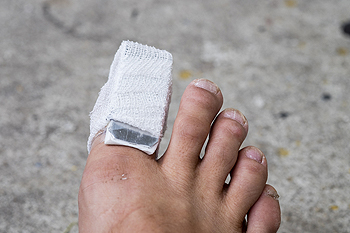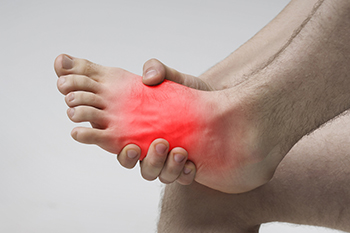June 2022
Surgery or Buddy Taping?

Falling is a common way to break a toe. Additionally, it can happen if a heavy object falls on it, or from unexpectedly stepping off of a curb. The symptoms are immediate when a broken toe has occurred. These can include bruising, swelling, and the pain can be devastating. If the fracture is severe, the toe may look deformed, and may even protrude from the skin. Many people find it difficult to walk on a broken toe. It is beneficial to seek medical attention when you have a broken toe, as patients who do not receive the correct treatment may develop an infection, or the injury may result in a permanent deformity. If the break is mild, buddy taping may be an effective treatment method. This consists of taping the affected toe to the toe next to it. This is often a successful way to provide stability as the healing process takes place. For severe breaks, surgery may need to be performed to realign the toe. If you believe you have broken your toe, it is beneficial to consult with a podiatrist who can recommend the correct form of treatment for you.
Broken toes may cause a lot of pain and should be treated as soon as possible. If you have any concerns about your feet, contact one of our podiatrists from Family Foot Care. Our doctors will treat your foot and ankle needs.
What Is a Broken Toe?
A broken toe occurs when one or more of the toe bones of the foot are broken after an injury. Injuries such as stubbing your toe or dropping a heavy object on it may cause a toe fracture.
Symptoms of a Broken Toe
- Swelling
- Pain (with/without wearing shoes)
- Stiffness
- Nail Injury
Although the injured toe should be monitored daily, it is especially important to have a podiatrist look at your toe if you have severe symptoms. Some of these symptoms include worsening or new pain that is not relieved with medication, sores, redness, or open wounds near the toe.
If you have any questions, please feel free to contact our offices located in Valatie and Albany, NY . We offer the newest diagnostic and treatment technologies for all your foot care needs.
Do Your Child's Feet Hurt?
Why Is the Top of My Foot in Pain?

A variety of conditions may be responsible for causing pain in the top of your foot. You may have damaged soft tissue structures or even injured a bone. Symptoms may provide some clues as to the root of your foot pain. Severe, sudden pain may be due to a stress fracture of one or more of the bones of the foot, such as the metatarsals. If the pain worsens with activity, you may have extensor tendonitis. This occurs when the tendons on top of the foot that help you lift the toes become inflamed, due to wearing tight shoes, standing for a prolonged period or running on rugged terrain. Sinus tarsi syndrome is another type of severe top-of-foot pain that occurs in the tiny channel located between the ankle and the heel. It can occur after an ankle sprain or may result from chronic instability. If the pain in the top of your foot is burning or shooting, and is accompanied by a pins-and-needles or numbness, it may be due to a compressed nerve. Even though you experience symptoms in the foot, the actual damaged nerve may be pinched in the foot, legs, or lower back. If you notice a nodule under the skin on the top of the foot near a joint or tendon, it may be a ganglion cyst. These are just a few possible causes for pain on the top of the foot. To have your condition properly diagnosed and treated, visit a podiatrist, who is a physician specializing in foot and ankle care.
Foot Pain
Foot pain can be extremely painful and debilitating. If you have a foot pain, consult with one of our podiatrists from Family Foot Care. Our doctors will assess your condition and provide you with quality foot and ankle treatment.
Causes
Foot pain is a very broad condition that could be caused by one or more ailments. The most common include:
- Bunions
- Hammertoes
- Plantar Fasciitis
- Bone Spurs
- Corns
- Tarsal Tunnel Syndrome
- Ingrown Toenails
- Arthritis (such as Gout, Rheumatoid, and Osteoarthritis)
- Flat Feet
- Injury (from stress fractures, broken toe, foot, ankle, Achilles tendon ruptures, and sprains)
- And more
Diagnosis
To figure out the cause of foot pain, podiatrists utilize several different methods. This can range from simple visual inspections and sensation tests to X-rays and MRI scans. Prior medical history, family medical history, and any recent physical traumatic events will all be taken into consideration for a proper diagnosis.
Treatment
Treatment depends upon the cause of the foot pain. Whether it is resting, staying off the foot, or having surgery; podiatrists have a number of treatment options available for foot pain.
If you have any questions, please feel free to contact our offices located in Valatie and Albany, NY . We offer the newest diagnostic and treatment technologies for all your foot care needs.
The Dangers of Wearing Flip Flops

Many people enjoy wearing flip-flops during the warmer months. Their various colors and exemption of laces can make these types of shoes tempting to slip into. Research has indicated, however, that there may be some drawbacks to wearing flip-flops. Patients who frequently wear them may experience foot and ankle pain, in addition to walking differently. This may be a direct result of the flip-flops having no arch and little to no support. The toes must also work harder to keep these shoes on the feet. Additionally, flip-flop wearers often take shorter steps, and this can cause more stress to the overall body. Heel pain is also a common ailment among flip-flop wearers. Flip-flops generally have a thin sole and are backless, which can lead to the development of cracked heels. If you would like more information about the dangers of wearing flip-flops, please consult a podiatrist who can answer any questions you may have.
Flip-flops are not always the best choice of footwear. If you have any concerns about your feet or ankles, contact one of our podiatrists from Family Foot Care. Our doctors will assist you with all of your foot and ankle needs.
Flip-Flops and Feet
When the weather starts warming up, people enjoy wearing flip-flops. Flip-flops are comfortable, stylish, and easy to slip on and off; they're perfect for any summer beach goer. However, these shoes can cause harm to the feet.
How Can Flip-Flops Affect Me Long-Term?
- Ankle problems
- Hip problems
- Lower back problems
- Pain in the balls of the feet
- Problems with foot arches
- Changes in the way you walk
Are There Injuries Associated with Flip-Flops?
Yes. Since flip-flops are relatively weak and do not provide the same amount of support as sneakers, people who wear flip-flops regularly are more susceptible to injuries. On top of that, the open nature of the shoe makes your feet more prone to other problems, such as cuts and even infections. Common injuries and ailments include:
- Sprained ankles
- Blisters
- Infections
- Cuts and Scrapes
I like Wearing Flip-Flops. Are There Safe Alternatives?
When buying flip-flops, try to find ones that have sturdy soles and that are made of high-quality materials that will support for your feet. These flip-flops will cost more but will also last longer as a result.
If you have any questions please feel free to contact our offices located in Valatie and Albany, NY . We offer the newest diagnostic and treatment technologies for all your foot and ankle needs.
What is Diabetic Neuropathy?

Many people who have had diabetes for a long time may also have a condition known as diabetic neuropathy. The most common form is peripheral neuropathy, which in diabetics usually affects the feet. Symptoms include numbness, reduced ability to feel pain or temperature changes, and tingling or burning sensations. Sharp pains or cramps may also occur. These can further evolve into foot ulcers (wounds that do not heal properly) and infections from cracks or sores in the skin. If ignored or left untreated, gangrene may develop which could lead to surgery or amputation. The main causes of peripheral neuropathy are high levels of sugar and triglycerides in the blood which can damage the nerves and blood vessels in the feet. Since the symptoms of peripheral neuropathy develop over time, it is easy to overlook this condition. Daily foot care is imperative to maintain healthy feet. Another important way to prevent or handle diabetic neuropathy is to schedule regular visits to a podiatrist who can monitor the condition of your feet and treat them accordingly.
Neuropathy
Neuropathy can be a potentially serious condition, especially if it is left undiagnosed. If you have any concerns that you may be experiencing nerve loss in your feet, consult with one of our podiatrists from Family Foot Care. Our doctors will assess your condition and provide you with quality foot and ankle treatment for neuropathy.
What Is Neuropathy?
Neuropathy is a condition that leads to damage to the nerves in the body. Peripheral neuropathy, or neuropathy that affects your peripheral nervous system, usually occurs in the feet. Neuropathy can be triggered by a number of different causes. Such causes include diabetes, infections, cancers, disorders, and toxic substances.
Symptoms of Neuropathy Include:
- Numbness
- Sensation loss
- Prickling and tingling sensations
- Throbbing, freezing, burning pains
- Muscle weakness
Those with diabetes are at serious risk due to being unable to feel an ulcer on their feet. Diabetics usually also suffer from poor blood circulation. This can lead to the wound not healing, infections occurring, and the limb may have to be amputated.
Treatment
To treat neuropathy in the foot, podiatrists will first diagnose the cause of the neuropathy. Figuring out the underlying cause of the neuropathy will allow the podiatrist to prescribe the best treatment, whether it be caused by diabetes, toxic substance exposure, infection, etc. If the nerve has not died, then it’s possible that sensation may be able to return to the foot.
Pain medication may be issued for pain. Electrical nerve stimulation can be used to stimulate nerves. If the neuropathy is caused from pressure on the nerves, then surgery may be necessary.
If you have any questions, please feel free to contact our offices located in Valatie and Albany, NY . We offer the newest diagnostic and treatment technologies for all your foot care needs.







